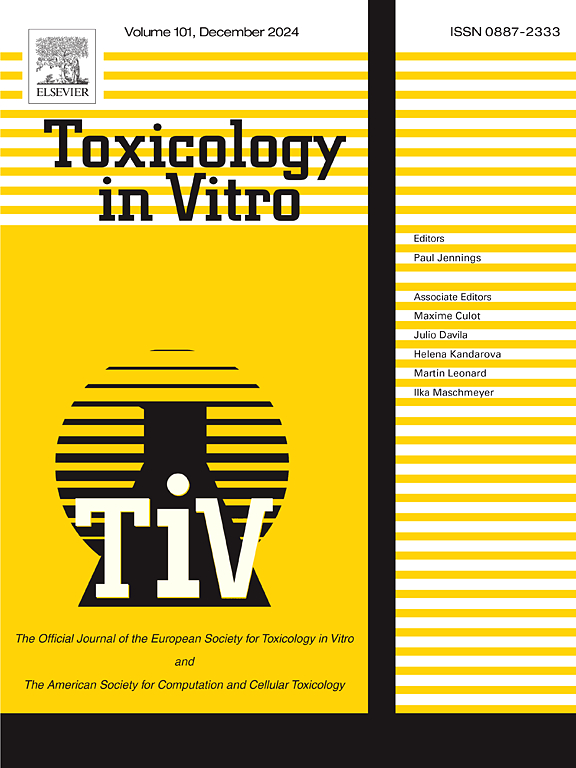Cross-species comparisons of plasma binding and considerations for data evaluation
IF 2.6
3区 医学
Q3 TOXICOLOGY
引用次数: 0
Abstract
The US Environmental Protection Agency is increasingly employing new approach methods (NAMs), including in vitro plasma binding and hepatocyte clearance experiments to collect chemical-species specific data. This paper presents data from plasma binding experiments using rapid equilibrium dialysis (RED) devices and plasma from humans, rats, and rainbow trout with a 4-h incubation time. A total of 54 chemicals, utilizing two concentrations, were tested across the three species resulting in 238 chemical-species specific datasets. Mass balance controls for chemical plasma stability and dialysis system recovery were used to evaluate the datasets and almost 40 % of the datasets (92/238 datasets) produced quantitative measurements. Cross-species comparisons and evaluations of the impact of physicochemical properties on chemical-assay performance were also evaluated. Comparisons of human-rat plasma binding revealed rat plasma generally demonstrated higher fup values for chemicals than human. While fup values in trout plasma were frequently lower than rat or human plasma. A comparison with literature data was performed and correlations between plasma binding, expressed as fraction unbound in plasma (fup), and log Kow across all three species indicate that the strongest relationship occurs at log Kow values between 1.5 and 4. The obtained datasets exhibited a wide range of behaviors, emphasizing the need for a robust approach to data quality assessment. The broader analysis of fup values indicates that chemicals with log Kow > 4.5 will be highly bound (fup ≤ 0.0001), difficult to measure, and have low reproducibility across laboratories, suggesting that use of different methods may be needed across different physicochemical properties.
血浆结合的跨物种比较和数据评估的考虑。
美国环境保护署越来越多地采用新的方法(NAMs),包括体外血浆结合和肝细胞清除实验来收集化学物种特异性数据。本文介绍了使用快速平衡透析(RED)装置和人、大鼠和虹鳟鱼的血浆进行4小时孵育的血浆结合实验的数据。总共54种化学物质,使用两种浓度,在三个物种中进行了测试,产生了238种化学物质特定的数据集。使用化学血浆稳定性和透析系统恢复的质量平衡控制来评估数据集,几乎40% %的数据集(92/238数据集)产生了定量测量。还评估了跨物种比较和物理化学性质对化学分析性能的影响。人-大鼠血浆结合的比较显示,大鼠血浆中化学物质的fup值普遍高于人血浆。而鳟鱼血浆中的fup值往往低于大鼠或人血浆。与文献数据进行了比较,发现三种物种的等离子体结合(用等离子体中未结合的分数(fup)表示)与log Kow之间的相关性表明,在log Kow值在1.5和4之间时,最强的关系发生。获得的数据集表现出广泛的行为,强调需要一种可靠的数据质量评估方法。对fup值的更广泛分析表明,具有log Kow > 4.5的化学物质将高度结合(fup ≤ 0.0001),难以测量,并且在实验室中的重现性较低,这表明可能需要使用不同的物理化学性质的不同方法。
本文章由计算机程序翻译,如有差异,请以英文原文为准。
求助全文
约1分钟内获得全文
求助全文
来源期刊

Toxicology in Vitro
医学-毒理学
CiteScore
6.50
自引率
3.10%
发文量
181
审稿时长
65 days
期刊介绍:
Toxicology in Vitro publishes original research papers and reviews on the application and use of in vitro systems for assessing or predicting the toxic effects of chemicals and elucidating their mechanisms of action. These in vitro techniques include utilizing cell or tissue cultures, isolated cells, tissue slices, subcellular fractions, transgenic cell cultures, and cells from transgenic organisms, as well as in silico modelling. The Journal will focus on investigations that involve the development and validation of new in vitro methods, e.g. for prediction of toxic effects based on traditional and in silico modelling; on the use of methods in high-throughput toxicology and pharmacology; elucidation of mechanisms of toxic action; the application of genomics, transcriptomics and proteomics in toxicology, as well as on comparative studies that characterise the relationship between in vitro and in vivo findings. The Journal strongly encourages the submission of manuscripts that focus on the development of in vitro methods, their practical applications and regulatory use (e.g. in the areas of food components cosmetics, pharmaceuticals, pesticides, and industrial chemicals). Toxicology in Vitro discourages papers that record reporting on toxicological effects from materials, such as plant extracts or herbal medicines, that have not been chemically characterized.
 求助内容:
求助内容: 应助结果提醒方式:
应助结果提醒方式:


